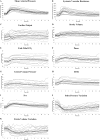Phenylephrine increases cardiac output by raising cardiac preload in patients with anesthesia induced hypotension
- PMID: 29569112
- PMCID: PMC6209056
- DOI: 10.1007/s10877-018-0126-3
Phenylephrine increases cardiac output by raising cardiac preload in patients with anesthesia induced hypotension
Abstract
Induction of general anesthesia frequently induces arterial hypotension, which is often treated with a vasopressor, such as phenylephrine. As a pure α-agonist, phenylephrine is conventionally considered to solely induce arterial vasoconstriction and thus increase cardiac afterload but not cardiac preload. In specific circumstances, however, phenylephrine may also contribute to an increase in venous return and thus cardiac output (CO). The aim of this study is to describe the initial time course of the effects of phenylephrine on various hemodynamic variables and to evaluate the ability of advanced hemodynamic monitoring to quantify these changes through different hemodynamic variables. In 24 patients, after induction of anesthesia, during the period before surgical stimulus, phenylephrine 2 µg kg-1 was administered when the MAP dropped below 80% of the awake state baseline value for > 3 min. The mean arterial blood pressure (MAP), heart rate (HR), end-tidal CO2 (EtCO2), central venous pressure (CVP), stroke volume (SV), CO, pulse pressure variation (PPV), stroke volume variation (SVV) and systemic vascular resistance (SVR) were recorded continuously. The values at the moment before administration of phenylephrine and 5(T5) and 10(T10) min thereafter were compared. After phenylephrine, the mean(SD) MAP, SV, CO, CVP and EtCO2 increased by 34(13) mmHg, 11(9) mL, 1.02(0.74) L min-1, 3(2.6) mmHg and 4.0(1.6) mmHg at T5 respectively, while both dynamic preload variables decreased: PPV dropped from 20% at baseline to 9% at T5 and to 13% at T10 and SVV from 19 to 11 and 14%, respectively. Initially, the increase in MAP was perfectly aligned with the increase in SVR, until 150 s after the initial increase in MAP, when both curves started to dissociate. The dissociation of the evolution of MAP and SVR, together with the changes in PPV, CVP, EtCO2 and CO indicate that in patients with anesthesia-induced hypotension, phenylephrine increases the CO by virtue of an increase in cardiac preload.
Keywords: Cardiac output; Fluid responsiveness; Hemodynamic monitoring; Phenylephrine; Pulse pressure variation.
Conflict of interest statement
Conflict of interest
Thomas W.L. Scheeren received honoraria for consulting and lecturing from Edwards Lifesciences and from Masimo Inc. (Irvine, CA, USA). TWLS received honoraria from Pulsion Medical Systems SE for giving lectures. TWLS is associate editor of the Journal of Clinical Monitoring and Computing, but has no role in the handling of this paper. For the remaining authors none were declared.
Ethical approval
All procedures performed in studies involving human participants were in accordance with the ethical standards of the institutional and/or national research committee and with the 1964 Helsinki declaration and its later amendments or comparable ethical standards.
Informed consent
Informed consent was obtained from all individual participants included in the study.
Figures



Comment in
-
Boosting systemic pressure with phenylephrine: arterial or venous modulation?J Clin Monit Comput. 2018 Dec;32(6):967-968. doi: 10.1007/s10877-018-0177-5. Epub 2018 Jun 29. J Clin Monit Comput. 2018. PMID: 29959580 No abstract available.
Similar articles
-
Preload dependency determines the effects of phenylephrine on cardiac output in anaesthetised patients: A prospective observational study.Eur J Anaesthesiol. 2016 Sep;33(9):638-44. doi: 10.1097/EJA.0000000000000470. Eur J Anaesthesiol. 2016. PMID: 27164015
-
Vasoconstriction with phenylephrine increases cardiac output in preload dependent patients.J Clin Monit Comput. 2024 Oct;38(5):997-1002. doi: 10.1007/s10877-024-01186-7. Epub 2024 Jun 21. J Clin Monit Comput. 2024. PMID: 38907106 Free PMC article.
-
Norepinephrine reduces arterial compliance less than phenylephrine when treating general anesthesia-induced arterial hypotension.Acta Anaesthesiol Scand. 2017 Jul;61(6):590-600. doi: 10.1111/aas.12905. Epub 2017 May 22. Acta Anaesthesiol Scand. 2017. PMID: 28543052
-
Fluid and vasopressor management for Cesarean delivery under spinal anesthesia: continuing professional development.Can J Anaesth. 2012 Jun;59(6):604-19. doi: 10.1007/s12630-012-9705-9. Epub 2012 Apr 24. Can J Anaesth. 2012. PMID: 22528166 Review. English, French.
-
The Efficacy and Safety of Norepinephrine and Its Feasibility as a Replacement for Phenylephrine to Manage Maternal Hypotension during Elective Cesarean Delivery under Spinal Anesthesia.Biomed Res Int. 2018 Dec 31;2018:1869189. doi: 10.1155/2018/1869189. eCollection 2018. Biomed Res Int. 2018. PMID: 30687737 Free PMC article. Review.
Cited by
-
Effect of 15° Reverse Trendelenburg Position on Arterial Oxygen Tension during Isoflurane Anesthesia in Horses.Animals (Basel). 2022 Feb 1;12(3):353. doi: 10.3390/ani12030353. Animals (Basel). 2022. PMID: 35158676 Free PMC article.
-
Journal of clinical monitoring and computing end of year summary 2018: hemodynamic monitoring and management.J Clin Monit Comput. 2019 Apr;33(2):211-222. doi: 10.1007/s10877-019-00297-w. Epub 2019 Mar 7. J Clin Monit Comput. 2019. PMID: 30847738 Free PMC article. Review.
-
Assessment of central hemodynamic effects of phenylephrine: an animal experiment.J Clin Monit Comput. 2019 Jun;33(3):377-384. doi: 10.1007/s10877-018-0204-6. Epub 2018 Sep 27. J Clin Monit Comput. 2019. PMID: 30264219
-
Boosting systemic pressure with phenylephrine: arterial or venous modulation?J Clin Monit Comput. 2018 Dec;32(6):967-968. doi: 10.1007/s10877-018-0177-5. Epub 2018 Jun 29. J Clin Monit Comput. 2018. PMID: 29959580 No abstract available.
-
Spectroscopic, quantum chemical, and topological calculations of the phenylephrine molecule using density functional theory.Sci Rep. 2025 Jan 2;15(1):208. doi: 10.1038/s41598-024-81633-2. Sci Rep. 2025. PMID: 39747169 Free PMC article.
References
-
- Thiele RH, Nemergut EC, Lunch C., 3rd The clinical implications of isolated alpha(1) adrenergic stimulation. Anesth Analg. 2011;113:197–304. - PubMed
Publication types
MeSH terms
Substances
LinkOut - more resources
Full Text Sources
Other Literature Sources
Medical
Research Materials
Miscellaneous

